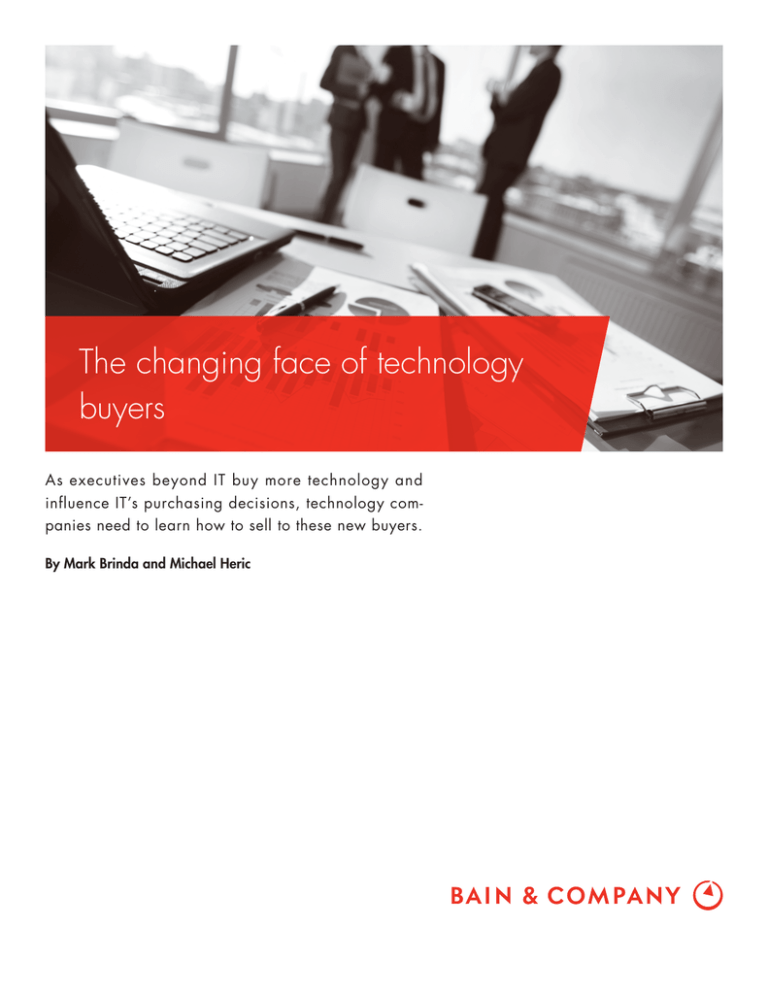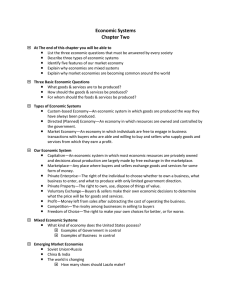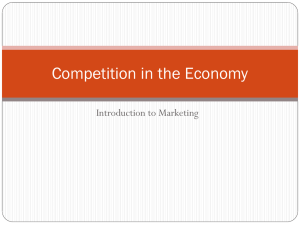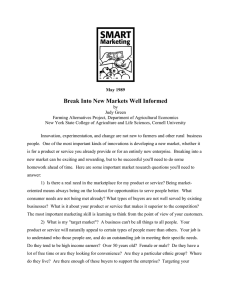The changing face of technology buyers
advertisement

The changing face of technology buyers As executives beyond IT buy more technology and influence IT’s purchasing decisions, technology companies need to learn how to sell to these new buyers. By Mark Brinda and Michael Heric Mark Brinda and Michael Heric are partners with Bain & Company in New York. Both work with Bain’s Global Technology practice. Copyright © 2014 Bain & Company, Inc. All rights reserved. The changing face of technology buyers The digitization of information, content and processes is transforming the technology buying process. A recent Bain & Company survey of the marketing, customer service and supply chain functions found that nearly one-third of technology purchasing power has moved to executives outside of IT. This has less to do with IT budgets being reallocated to the line of business than with non-IT business leaders transferring investments from labor and traditional services to new technology tools and technology-enabled services. thirds will come from new digitized workloads, such as digital advertising media buying systems that enable micro-segmentation and advanced customer analytics, according to our analysis and discussions with chief marketing officers in the US (see Figure 1). Purchasing decisions on this investment increasingly come from outside of IT, from general managers, business development executives, chief technology officers or the heads of functions, such as marketing, finance and human resources. Technology providers see this happening, but many are slow to respond. If they do not find ways to adapt, they risk slowing their own growth. Reaching these buyers will require a new go-to-market model, including updated offerings, pricing, salesforce and channel management, delivery, and post-sales support. (For more on the design and delivery capabilities that make up a go-to-market model, see the Bain Brief “Selling the cloud.”) Traditionally, chief information officers (CIOs) have called the shots in IT purchasing decisions after aligning with the business on its needs. At times, technology spending has moved from IT to other parts of the organization— as it did in the 2000s when companies began building websites—but typically, the CIO and IT have regained control once the technology matures and cost pressures arise. Digitization, however, is bringing a more permanent change to the IT buying process, one that will create a far more complex sales environment for technology providers. Whereas responsibility for managing and maintaining a website can shift, organizations transforming work processes through digitization must retain authority over those processes. While this shift in buying power presents new opportunities for technology providers, most are not set up to sell to these new buyers. The technology buying process transformed The role of the CIO will change in these disrupted areas, but that change will differ from one organization to another. In some cases, the CIO will still lead the decision-making process from beginning to end, but with expanded influence and support from functional buyers. In other cases, the CIO will become one of many stakeholders involved in the decision. And in some situations, buyers outside of IT will control the decision-making process from beginning to end, with little to no involvement from the CIO and IT. Changes in technology spending The digitization of business is shifting enterprise-level investments in technology along two dimensions. First, investment is moving from traditional workflows, such as print ad targeting in marketing, to new digital workflows, such as mobile ad targeting and delivery. Investment is also being directed from within the enterprise to a new generation of third-party service providers. New business models, like pay-for-performance and as-aservice, will displace traditional models, such as perpetual software licenses. Technology providers are responding—but not always successfully. Some fall into one of three common traps as they evolve their go-to-market models. One trap is the belief that the growing influence of business buyers in IT purchasing decisions will be similar across functions and industries. A number of factors shape the decision-making roles of business buyers and traditional IT decision makers, including technology’s role in enabling business outcomes, the speed at which the business needs to move, the integration requirements with other IT systems and the company culture. For example, marketing executives have become much more These changes affect billions of investment dollars: The $1.5 trillion invested in marketing and communications worldwide in 2012 is expected to grow to $1.7 trillion by 2017. Of that roughly $200 billion in growth, two- 1 The changing face of technology buyers Figure 1: Two-thirds of the growth in marketing spending will come from new digitized work processes CAGR (12–17F) ~3% Global marketing investment $2,000B 1,500 ~$1.5T $.2T ~$1.7T External (new) Internal (new) External (new) External (new) 1,000 500 0 External (traditional) External (traditional) Internal (traditional) 2012 8% • • • • • 4% • Marketing operations automation • Customer database management • Lead generation and management 2% • Creative design agencies • PR firms 1% • Traditional media investment (print, TV) • Internal labor force - Product managers - Marketing mix planners - Brand managers Internal (new) Internal (new) Internal (traditional) 2012−17 growth Sources of investment Advanced customer analytics Marketing mix models Cross-channel campaign management Hyper-personalization Advertising media buying systems 2017F Notes: Traditional processes are workflows and solutions not being drastically disrupted by technology-enabled business solutions. New processes are workflows and solutions being drastically disrupted or made possible by technology-enabled business solutions. Marketing mix models enable marketers to track, manage and optimize spending across different channels, such as TV, events or print. Cross-channel campaign management is the process of tracking the effectiveness of marketing campaigns across TV, print, online and other channels to optimize performance. With hyper-personalization, instead of generating a handful of ads or offers for a target segment, marketers make a completely custom ad or offer for the individual based on data gathered from digital sources in real time. Sources: Forrester Research; Gartner; Chief Marketing Officer Council; IDC; eMarketer; Bain interviews with providers and experts the company engaged the senior management team to explore whether to build or buy. Senior managers decided to buy a smaller company with the right technology so they could move quickly into this rapidly developing space. Teams from business development and finance identified and screened target companies. Only after one was identified and negotiations were under way did they bring in the CIO and IT team to conduct technical due diligence. If a technology provider had wanted to influence this company to build a new payment platform rather than buy one, having a relationship only with the CIO and the IT team would not have been good enough given the late stage they were brought into the process. influential in technology purchases than their peers in customer service or in supply chain, where IT still leads decision making due to integration requirements with legacy IT systems (see Figure 2). Another common trap that many technology providers fall into is telling their sales teams, who have built up relationships with IT buyers, to simply extend their sales efforts to the buyers in the lines of business. This oversimplifies the complexity of the changes under way. A general manager contemplating an investment in a new digital business requires a very different engagement approach than a functional buyer like a chief marketing officer or the head of human resources. In the case of general managers, the dialogue is typically more focused on growth and the impact technology decisions have on the broader strategic choices general managers will make. In the case of functional buyers, the dialogue is typically more focused on return on investment and cost. A third trap is assuming traditional offerings and solution marketing can be easily adapted for use in the processes that digitization is reshaping. IT buyers are accustomed to evaluating an offering’s technology features and functionality, and their teams are comfortable doing a substantial amount of integration and customization work. Many business buyers take a very different approach to evaluating offerings. They tend to look at For example, when a leading financial services company identified a need to develop a digital payments platform, 2 The changing face of technology buyers the business outcomes they can achieve and place more emphasis on time to value, whereas IT buyers are open to extending implementation timelines if that is required to achieve deep integration with existing systems. In some cases, technology providers will need to invest in significantly adapting their offerings and supporting marketing and sales content to be effective in these new markets. The first type is the CIO and the traditional IT buyer. The CIO will not only continue to be a critical buyer of IT products and services, but also a key influencer of IT spending regardless of where purchasing decisions are made. Most enterprise technology providers already focus on the CIO and have optimized their offerings, sales and marketing, delivery and support around them. The new challenge is these buyers are no longer driving growth in the way they had in the past. To respond successfully to these changes, technology providers must understand how businesses will make technology decisions and learn how they will want to buy. Providers will also need to create new offers and go-tomarket models that meet businesses’ needs and train their sales teams to forge meaningful business relationships. The second type is the functional buyer, such as the chief sales officer or chief supply chain officer. Historically, these buyers would describe a business need to the IT department, which would then explore potential IT solutions. IT would then share various options with the business buyers and in some cases make the decision on a solution with limited involvement from the executives. Prices were typically fixed, and implementation times were longer given the integration requirements. The process has evolved over the past few years, and this new group of buyers values speed and time to value above all else. Cloud solutions are particularly appealing Tapping into the buyers of the future To succeed, technology providers will need to understand who the buyers are and how to sell most effectively to them. Digitization will require providers to evolve their offerings and go-to-market models to appeal to four broad types of buyers. Figure 2: The CIO’s role is changing, in some functions more than others; marketing executives, for example, have more decision rights over technology purchases than supply chain executives have Technology-related purchase decisions 100% ~30% 80 ~50% ~75% 60 ~35% 40 ~40% 20 ~35% ~25% ~10% 0 Marketing IT has decision rights, often with the business unit Customer Line of business has decision rights; IT plays an advisory role with high involvement throughout buying process Source: Bain & Company 3 Supply chain Line of business has decision rights; IT has limited involvement The changing face of technology buyers to them, not only because they can try before buying and then deploy rapidly, but also because these solutions offer flexible pricing models. Technology providers will need to tailor their offers and go-to-market models to meet the needs of functional buyers at each stage of this new customer life cycle. for example, it evolved from a pure service provider to a software company. Similarly, when FedEx and UPS developed supply chain management services and solutions, they evolved from IT customers to service providers competing with other outsourcers offering supply chain management services. The lines between customer and competitor blur. Many of these buyers find it challenging to purchase from some technology providers, since those providers tailor their offers and go-to-market models to meet the needs of enterprise customers. These buyers are looking either for platforms or components to build platforms that scale rapidly to deliver services to their customers. Companies that have been successful with these buyers have designed their go-to-market model around a free or low-cost initial trial, demonstrating measurable business impact, expanding usage by monitoring and reporting the value they have created, and then quickly reengaging to introduce additional offerings. This is fundamentally different from investing in a long sales cycle that results in a large, one-time IT purchase with a multiyear service contract attached. Many technology sales organizations are struggling to make this shift. Ensuring your go-to-market model is fit for purpose The changes in the technology buying process will lead to rich discussions as senior executives respond and adapt their strategies and business models. Among the questions they should be asking: A third type of buyer is the general manager or business development executive looking to create new growth businesses. These buyers often acquire smaller providers so they can quickly launch new digital businesses, such as when Monsanto ventured into self-service underwriting for weather insurance through its purchase of The Climate Corporation. In situations where they invest to build their own platforms, the chief technology officer and R&D teams tend to lead the decision process, with IT coming in at a later stage to operate and maintain the selected technology platform. The CIO and IT often get involved after the business has made critical decisions about design and technology vendors. Technology providers need to evolve their go-to-market models to participate in these business dialogues earlier. The effectiveness of a provider’s go-to-market model is measured less on the strength of the relationship with the CIO and IT and more around managing a complex web of business and IT stakeholders. Finally, third-party solution providers and independent software vendors that build service platforms represent a fourth type of buyer. Some technology providers see these buyers as competitors rather than customers, so they prefer not to build relationships with them. When business process outsourcer ADP began to develop human resources software-as-a-service applications, 4 • Which buyers will be important to pursue to drive future growth? • How can we change new buyers’ perceptions, so they will think of us as partners in the areas affected by digitization instead of associating us with traditional IT? • How can we reach new buyers without involving the CIO or putting our IT relationships at risk? • Are our products and services appropriately configured so new buyers will want to buy and consume them? For example, do we have the right pricing models and self-service provisioning? • What delivery, implementation and support model do we need, to demonstrate value and expand our accounts using an as-a-service or pay-for-performance pricing model? Shared Ambit ion, True Results Bain & Company is the management consulting firm that the world’s business leaders come to when they want results. Bain advises clients on strategy, operations, technology, organization, private equity and mergers and acquisitions. We develop practical, customized insights that clients act on and transfer skills that make change stick. Founded in 1973, Bain has 50 offices in 32 countries, and our deep expertise and client roster cross every industry and economic sector. Our clients have outperformed the stock market 4 to 1. What sets us apart We believe a consulting firm should be more than an adviser. So we put ourselves in our clients’ shoes, selling outcomes, not projects. We align our incentives with our clients’ by linking our fees to their results and collaborate to unlock the full potential of their business. Our Results Delivery® process builds our clients’ capabilities, and our True North values mean we do the right thing for our clients, people and communities—always. Key contacts in Bain & Company’s Global Telecommunications, Media and Technology practice: Americas: Mark Brinda in New York (mark.brinda@bain.com) Michael Heric in New York (michael.heric@bain.com) Dianne Ledingham in Boston (dianne.ledingham@bain.com) Asia-Pacific: Kevin Meehan in Singapore (kevin.meehan@bain.com) Europe: Stephen Bertrand in London (stephen.bertrand@bain.com) For more information, visit www.bain.com








